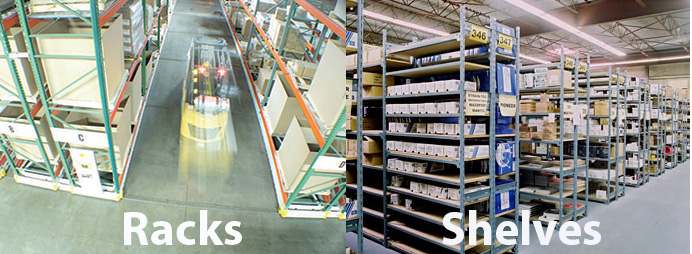Cleanliness isn’t next to godliness, but orderliness generally accompanies success for businesses and other organizations. Workers in warehouses may puzzle over best ways to store and access materials. Understanding the difference between shelving and racking can help any workplace become more efficient.
Without this understanding, organizations that require sophisticated storage solutions for shelving and racking in Vancouver may create confusion and slow down progress for employees. Instead of helping to meet the needs of customers throughout British Columbia, employees may find themselves in an endless round of struggling to access and store inventory and other materials.
Considering the basic differences between shelving and racking products is a good starting point for designing storage that is sensible and easy to access.

Racking Doesn’t Equal Shelving
Racking generally spans a wider space, is deeper and is stacked higher than shelving. It is built and installed in a manner that makes it possible to access materials — such as large boxes or entire pallets of goods — with cherry pickers, forklifts or mechanized systems that move materials down to ground level. In most cases Racking takes advantage of the Vertical height to increase Cubed density.
Some kinds of racking — such as at a home improvement center — may be accessed by hand, but are cantilevered so that long, unobstructed racks can store lumber. One warehouse may need tall tiers of deep racks that are strong enough to support a multitude of heavy pallets and are only accessible via machines. One area may need specialty brackets to display mouldings or wire . Another may need tall racks combined with a steel mesh, industrial mezzanine so employees can get into higher storage areas. Yet, even in some warehouses, towering rows of racks may not be an appropriate choice at all. This is especially true in situations where shelving is more useful.
Shelving systems are for materials that almost always need to be accessed by hand, such as books, small boxes of medicine and auto accessories. Shelving often offers solid, counter-like surfaces on which to support items. It usually doesn’t have the mesh platforms, openness or the scaffold-like look of racking.
However, shelving may also be mechanized so that shelves can be moved together or apart easily, such as in a university archive, restricted library stacks or law enforcement evidence lockers.
Shelving vs. Racking Materials
Racks accessed by machines need to be tougher than shelves accessed by hand. They also have to support the heavy weight of tier upon tier of palletized materials and withstand accidental impacts from forklifts.
Not that shelving is delicate, but it doesn’t usually have to put up with crash-and-bash action. Often, it is only open at the front, which keeps smaller items from falling out the back or sides. Instead of steel railing, columns and mesh, shelves usually require the more finished look of wood, glass or laminated materials.
Brainstorming Storage Solutions
Brainstorming sessions with all employees can help to shed light on storage needs that management may not have considered. This not only lets staff know that everyone is a stakeholder in the organization’s success but also leads to good planning.
When everyone gets together to discuss needs, wants and knowledge about storage, it’s easier to create a common sense plan for customized solutions. A bit of input from a professional storage designer can also help industries, agencies and organizations to maximize space and access to materials.
Purchasing the right racking or shelving in Vancouver and making workplaces work, depend on putting heads together to seek solutions.

